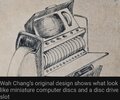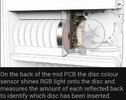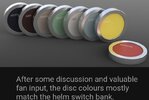I know. I was shocked. I mean, I like to think I made a compelling case for it, but since when has logic worked on this planet?An interesting thing to note - the colors were NOT the *only* thing TWC changed here. They also went with Peregrinus' complete list of functions associated with the new colors.
You are using an out of date browser. It may not display this or other websites correctly.
You should upgrade or use an alternative browser.
You should upgrade or use an alternative browser.
The Wand Company TOS Tricorder is coming!
- Thread starter Jediwannabe
- Start date
JiminSTLouis
Master Member
I was referring to you Brian for bringing it up in their blog.Chris and the rest of the gang at TWC!
So... who among us is going to be obsessed with getting the function labels all lined up in the Tricorder even though you won’t see the words?
asalaw
Master Member
Probably me.So... who among us is going to be obsessed with getting the function labels all lined up in the Tricorder even though you won’t see the words?
I know. But they deserve the credit for actually making the changes.I was referring to you Brian for bringing it up in their blog.
I actually thought about mentioning the idea of placing two function labels on the disc, curved across the top and bottom:So... who among us is going to be obsessed with getting the function labels all lined up in the Tricorder even though you won’t see the words?
I didn't want to press my luck though, and the color was FAR more important an issue.
That said, I'm not sure I like it better or worse than the horizontal labeling. The one thing that such labeling has going for it is more 'uniform' wear on the 'metal' paint/plating/whatever. With dual, curved labels, there is no specific orientation that most would be inclined to naturally use. As such, the paint, et al would last longer with this orientation. And since one has to use these a LOT, saving wear and tear should definitely be a consideration.
EDIT: The more I look at it, the more I think the curved idea, while likely saving on wear and tear, is the LESS visually pleasing and series-reflective alternative.
Last edited:
AnubisGuard
Master Member
Is there any precedent for that kind of curved labelling in TOS, or is it taking away from it being a prop replica?
Sorry. Had to ask .
Sorry. Had to ask .
There are indeed some quite literally BIG precedents for curved labeling in StarfleetIs there any precedent for that kind of curved labelling in TOS
A *real* Star Trek fan would have known that - heh.
AnubisGuard
Master Member
Struggling...not...to continue...joke. 
Britcinescribe
Well-Known Member
Personally, I like the more fun vibrant colours for the reasons that Chris outlined in his reply. But, if they go with this more muted set, I'm okay with that too. Whatever!It looks like TWC updated their color palette for the data disks on their blog.
Original
View attachment 1460904
New
View attachment 1460905
View attachment 1460906
asalaw
Master Member
Can't say I disagree with that--I just can't get all hot and bothered about it. BTW, three more days till we get the straight poop on the disks!Personally, I like the more fun vibrant colours for the reasons that Chris outlined in his reply. But, if they go with this more muted set, I'm okay with that too. Whatever!
JiminSTLouis
Master Member
I think Monday is a holiday in the UK so we’ll probably have to wait until Tuesday.Can't say I disagree with that--I just can't get all hot and bothered about it. BTW, three more days till we get the straight poop on the disks!
asalaw
Master Member
Just checked. It is indeed a bank holiday in the UK. Bugger.I think Monday is a holiday in the UK so we’ll probably have to wait until Tuesday.
Prop Collector
Sr Member
Our first task was to design an ejector mechanism that would work smoothly and reliably, and fit in the limited space the prop has to offer in this area. The eight-disc array is fairly tightly boxed in between the hood, the lower compartment cavity wall and the back of the tricorder. Disc insertion and ejection is further complicated by the fact that the disc diameter is larger than the apparent opening the discs must pass through to be taken in and out of their dock. An array of spring-loaded latching switches attached to thin, crescent-shaped, bendy ‘catcher’s mitts’, which flex to hold and eject the discs, coupled with an upper “glamour bar” that rotates out of the way when a disc is ejected, provided the aesthetic functionality we were after. With all the discs inserted, and while being displayed in a cabinet, the glamour bar springs into position over the top of the array and the tricorder looks perfectly like a pristine version of the first season hero. But for those that want to boldly go beyond display and into the realm of realistic function, pressing any one of the discs ejects it with a satisfyingly premium click. The latching switch at the back of each disc slot tells the tricorder’s software which of the slots have discs in them.
With the ejector’s mechanical design well on the way to completion, we went to work on making the discs a plausibly functional part of the tricorder’s operation. Initially, we considered ways of ‘writing’ even just small amounts of data wirelessly to the discs (using an RFID chip embedded in the disc), but technical issues caused by the proximity of discs to each other, and the metal outer ring, closed down that idea. Given the capability of the tricorder’s internal electronics, and the onboard memory’s ability to cope with the functions we had planned for it, our thinking moved away from the complexity of adding hardware to each disc. To make the discs integral to the tricorder’s operation, for example, using them to activate the tricorder’s various functions, the tricorder has to be able to identify each disc. To simplify the identification process and add another level to the interaction required by the user to operate the tricorder, we chose to only monitor the disc slot furthest to the right. Using this as the activation position ties nicely in with the possibility that, in the hero prop’s original incarnation, this particular disc was the removable one. The right-most slot also allows us to hide the disc identification sensor behind the moiré panel.
The tricorder is not just a replica of a measuring and recording device: it is a realistic incarnation of one of science fiction’s most heroic props and perhaps the earliest vision of a mobile computing future that we all now take for granted. At its heart, our tricorder replica isn’t a scientific instrument – in the round, it’s the embodiment of a shared dream that every Star Trek fan holds dear.
Prop Collector
Sr Member
Functions:

Oh, that kind of orientation. I thought it was sort of an interactive in-universe operators' manual. What they're describing would be more accurately orienteering.
enterprise0216
Sr Member
Here are some pics from the latest Tricorder email released today. Great details i had to read the email twice..L. Looking forward to the next release.
Attachments
Last edited:
Britcinescribe
Well-Known Member
Got it in the UK this morning. I'm loving these newsletters.
Notice the comment "fan input". We're famous!
I love the RGB reader. This is ******* crazy engineering, but that's why TWC works so well. Moving the discs around will simultaneously be a pain, and great fun! I can't wait to see this thing working.
I hope we'll get a McCoy medical scanner at some point. (Shove some Apple Watch sensors into the bottom of it to give it a legitimate reason to be made!)
Notice the comment "fan input". We're famous!
I love the RGB reader. This is ******* crazy engineering, but that's why TWC works so well. Moving the discs around will simultaneously be a pain, and great fun! I can't wait to see this thing working.
I hope we'll get a McCoy medical scanner at some point. (Shove some Apple Watch sensors into the bottom of it to give it a legitimate reason to be made!)
Similar threads
- Replies
- 3
- Views
- 1,596
- Replies
- 7
- Views
- 1,836
- Replies
- 10
- Views
- 2,018
- Replies
- 4
- Views
- 2,115




